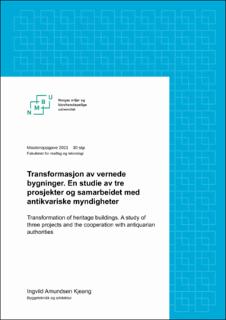| dc.contributor.advisor | Houck, Leif Daniel | |
| dc.contributor.author | Kjeang, Ingvild Amundsen | |
| dc.coverage.spatial | Norway, Oslo | en_US |
| dc.date.accessioned | 2021-12-29T14:32:35Z | |
| dc.date.available | 2021-12-29T14:32:35Z | |
| dc.date.issued | 2021 | |
| dc.identifier.uri | https://hdl.handle.net/11250/2835593 | |
| dc.description.abstract | Temaet for denne oppgaven er transformasjon av vernede bygninger. Vernede bygninger regnes som kulturminner og kan være fredet, regulert til bevaring eller kommunalt listeført. Gjennom transformasjon kan eldre bygninger tilpasses ny bruk eller ny funksjonalitet, de kan bli mere energieffektive og på den måten bidra til å redusere klimagassutslipp. Å bevare en bygning fremfor å rive og bygge nytt, er også svært viktig i et klimaperspektiv. Vernede bygninger utgjør en viktig ressurs for god byutvikling og for å sikre attraktive byområder (Meld. St. 16 (2019-2020)).
Den franske restaureringsarkitekten Eugène Viollet-le-Duc sa allerede på 1800-tallet at «den beste måten å konservere en bygning på er å bruke den» (Hinsch et al., 1975 s.20). Bygningsvern i Norge startet som en del av oppbyggingen av Norge som selvstendig stat etter 1814. I dag er bygningsvern en oppgave for kulturmiljøforvaltningen. I Oslo har Byantikvaren ansvar for å ivareta vernede bygninger. Et transformasjonsprosjekt må gjennomføres i samarbeid med vernemyndigheter og kommunen. Byantikvaren er rådgiver i saker som gjelder kulturminner og skal gi uttalelser til byggesaker.
Oppgaven skal undersøke om det er mulig å finne frem til en gjennomføringsmodell for samarbeidet mellom antikvariske myndigheter og sentrale aktører i transformasjonsprosjekter. For å bli kjent med temaet ble det utført en pilotundersøkelse som besto av fem samtaler med fagpersoner med kjennskap til transformasjon. For å få svar på problemstillingen er det studert tre transformasjonsprosjekter i Oslo. Det er gjennomført intervjuer av arkitekter og prosjektledere i disse prosjektene. Byantikvaren ble også intervjuet. I tillegg ble saksdokumenter studert. I litteraturstudien ble det opparbeidet kunnskap om transformasjon, bygningsvern og prosjektgjennomføring.
Casene som er studert viser fellestrekk i gjennomføringen, som tidlig involvering av antikvariske myndigheter som en aktør og bruk av samspillkontrakt. Innenfor samspillkontrakten var tillit, dialog og en åpenhet om kostnader sentralt. Løsninger ble funnet underveis i prosessen og var et resultat av dialog mellom arkitekter, oppdragsgiver og vernemyndigheter. Arbeidet på byggeplassen ble fulgt opp tett av prosjektlederne. Aktørene hadde generelt god forståelse for vernehensyn. Prosessen ble også strukturert ved at søknader til kommunen fungerte som milepæler.
Resultatene viser at det er mulig å utforme en gjennomføringsmodell som kan gjelde også for andre prosjekter, men som likevel må tilpasses det enkelte prosjekt og aktørene som er involvert. I tillegg vil gjennomføringen avhenge av vernestatus og hvilke ressurser vernemyndigheter har til disposisjon for de enkelte prosjektene. | en_US |
| dc.description.abstract | The topic of this thesis is transformation of heritage buildings. Heritage buildings can be protected by law or other measures. Through transformation older buildings can be adapted to new purposes. They can become more energy efficient and contribute to a reduction of greenhouse gas emissions. Thus, preservation of old buildings is important from a climate perspective. Heritage buildings constitute an important resource in urban development and in making urban areas attractive (Meld. St. 16 (2019-2020)).
The French restoration architect Eugène Viollet-le-Duc said early in the 19th century that «the best way to conserve a building is to use it» (Hinsch et al., 1975 s.20). Conservation of heritage buildings started in Norway as part of the development of the country as an independent state after 1814. Today, building conservation is a task for the cultural environment administration. In Oslo «Byantikvaren» is the antiquarian authorities and is responsible for taking care of heritage buildings. A transformation project must be carried out in collaboration with antiquarian authorities and municipalities. Byantikvaren is advisor in matters concerning cultural monuments and shall give statements on building matters.
The thesis will investigate whether it is possible to find an implementation model for cooperation between the antiquarian authorities and key actors in transformation projects. To become familiar with the topic, a pilot survey was carried out consisting of five conversations with professionals with experience from transformation or conservation. Knowledge about transformation, building conservation and project implementation was acquired through a literature study. To answer the question concerning the implementation model, three transformation projects in Oslo were studied. Byantikvaren, architects and project managers in the three projects were interviewed and documents were studied.
The results show that the projects were carried out in a similar way in certain aspects such as early involvement of antiquarian authorities as a key actor and the use of «partnering». Within this kind of contract, trust, dialogue and an open communication was important. Solutions were found during the process and were the result of dialogue between architects, the client and the antiquarian authorities. Work on the construction site was followed up closely by the project managers. The participants also had an adequate understanding of conservation of heritage buildings. The process was also structured by the fact that applications to the municipality served as milestones.
The results show that an implementation model can be designed that also may be applied to other projects. The model must, however, be adapted to the single project and the participants involved. In addition, implementation will depend on the cultural heritage value of the building and the resources available by the antiquarian authorities. | en_US |
| dc.language.iso | nob | en_US |
| dc.publisher | Norwegian University of Life Sciences, Ås | en_US |
| dc.rights | Attribution-NonCommercial-NoDerivatives 4.0 Internasjonal | * |
| dc.rights.uri | http://creativecommons.org/licenses/by-nc-nd/4.0/deed.no | * |
| dc.title | Transformasjon av vernede bygninger : en studie av tre prosjekter og samarbeidet med antikvariske myndigheter | en_US |
| dc.title.alternative | Transformation of heritage buildings : a study of three projects and the cooperation with antiquarian authorities | en_US |
| dc.type | Master thesis | en_US |
| dc.description.localcode | M-BA | en_US |

